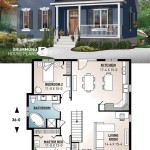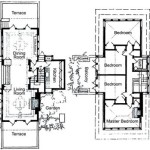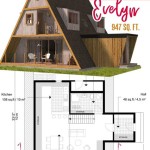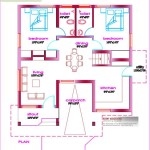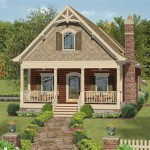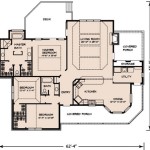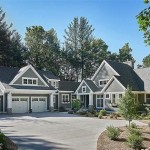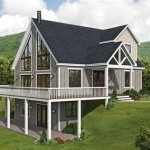House Plans: The Allure of Round Home Design
Round homes, also known as circular homes or geodesic domes, represent a departure from traditional rectangular architecture. They offer a unique aesthetic and potential benefits related to energy efficiency and structural integrity. This article will explore the key considerations, advantages, and challenges associated with round home design, focusing on house plans and the process involved in bringing such a structure to life.
The popularity of round homes has fluctuated over the decades, often associated with movements emphasizing environmental consciousness and alternative living. While not yet a dominant architectural style, round homes continue to appeal to individuals seeking non-conventional housing solutions and a closer connection with their surroundings. Understanding the intricacies of planning and construction is paramount before embarking on a round home project.
Key Point 1: Understanding the Advantages of Round Home Design
Round homes exhibit several potential advantages compared to conventional rectangular houses. These advantages stem from the inherent geometry of a circle, influencing various aspects of the home's performance and living experience.
One of the primary advantages is energy efficiency. The reduced surface area-to-volume ratio in a round house minimizes heat loss during colder months and heat gain during warmer months. This, in turn, can lower heating and cooling costs. The shape also facilitates natural airflow and ventilation, further contributing to energy savings. Fewer corners also mean less wind resistance, potentially reducing heating costs in windy climates.
Structural integrity is another key benefit. The circular shape distributes stress evenly throughout the structure, making round homes more resistant to strong winds, earthquakes, and other natural disasters. This inherent stability stems from the fact that loads are distributed around the perimeter and supported by a continuous frame, rather than concentrated at specific points.
Aesthetic appeal is often a driving factor for those choosing a round home design. The curved walls and open floor plans create a unique and inviting atmosphere. Natural light tends to be more evenly distributed throughout the space, enhancing the overall ambiance. The organic flow and unconventional layout can also be customized to reflect the homeowner's personal style and preferences.
Reduced material usage can sometimes be an advantage, particularly in the context of geodesic dome construction. Geodesic domes utilize a network of interconnected triangles, which can be prefabricated and assembled on-site. This method allows for the efficient use of materials and minimizes waste compared to conventional framing methods. However, the overall material usage depends heavily on the specific design and construction techniques employed.
Key Point 2: Navigating the Challenges of Round Home Design
Despite the advantages, round home design presents unique challenges that must be addressed during the planning and construction phases. These challenges can impact cost, construction time, and overall livability.
Customization and Furniture Placement pose a significant hurdle. Conventional furniture is designed for rectangular spaces, and fitting it into curved walls can be challenging. Custom-built furniture is often necessary, adding to the overall cost. Arranging furniture and decor in a round room requires careful planning to maximize space utilization and create a cohesive design.
Construction Complexity and Code Compliance can also present difficulties. Building codes are primarily geared toward rectangular structures, and obtaining permits for a round home may require additional documentation and approvals. Finding contractors experienced in round home construction can be challenging, and specialized techniques may be required for framing, roofing, and finishing the interior and exterior.
Cost Considerations can be a major factor. While some aspects of round home construction, such as reduced material usage in geodesic domes, may lower costs, other factors can increase expenses. Custom furniture, specialized construction techniques, and potential delays due to code compliance issues can contribute to a higher overall project cost compared to a conventional rectangular home.
Window and Door Placement requires careful consideration. Standard rectangular windows and doors may not fit seamlessly into a curved wall, requiring custom solutions or creative adaptations. The placement of windows and doors also needs to be carefully planned to maximize natural light and ventilation while maintaining energy efficiency and structural integrity.
Plumbing and Electrical Systems must be adapted to the curved walls and unique layout of a round home. Running pipes and wires through curved walls can be more complex than in a rectangular structure, potentially increasing labor costs. Careful planning and coordination are necessary to ensure that these systems are properly installed and meet all safety requirements.
Key Point 3: Practical Considerations for Round Home Plans
Developing effective house plans for a round home requires a thorough understanding of the design principles, construction techniques, and practical considerations involved in creating a functional and livable space. Key aspects to consider include floor plan layout, structural design, and material selection.
Floor Plan Design is crucial for maximizing space utilization and creating a comfortable living environment. Open floor plans are commonly used in round homes to take advantage of the natural flow of the circular shape. Careful consideration should be given to the placement of bedrooms, bathrooms, and other functional areas to ensure privacy and convenience. The central area of the home often serves as a living or dining space, with bedrooms and other rooms radiating outwards.
Structural Design is paramount for ensuring the stability and durability of the round home. Common construction methods include geodesic domes, monolithic domes, and timber-framed structures. Geodesic domes utilize a network of interconnected triangles to distribute stress evenly, while monolithic domes are constructed from a single layer of concrete. Timber-framed structures use curved or segmented beams to create the round shape. The choice of construction method will depend on factors such as budget, climate, and local building codes.
Material Selection plays a significant role in the energy efficiency, aesthetics, and environmental impact of the round home. Sustainable and eco-friendly materials are often favored in round home construction. Recycled materials, renewable resources, and locally sourced materials can help reduce the carbon footprint of the building. The choice of exterior siding, roofing materials, and interior finishes will also impact the overall appearance and performance of the home.
Window and Door Design is essential for maximizing natural light, ventilation, and energy efficiency. Skylights are often incorporated into round home designs to provide ample natural light. The size, shape, and placement of windows and doors should be carefully considered to minimize heat loss or gain. High-performance windows and doors with energy-efficient glazing can help reduce energy consumption and improve indoor comfort.
Interior Design must be carefully planned to complement the unique architecture of the round home. Curved walls and open floor plans require a different approach to interior design than conventional rectangular spaces. Furniture should be carefully selected to fit the curved walls and maximize space utilization. Creative use of lighting, color, and texture can enhance the overall ambiance and create a cohesive design.
Landscaping and Site Integration are important considerations for creating a harmonious relationship between the round home and its surroundings. The shape of the house can be echoed in the landscaping design, with curved paths, circular gardens, and rounded planting beds. The orientation of the house should be carefully considered to maximize solar gain in the winter and minimize heat gain in the summer. Native plants and drought-tolerant landscaping can help reduce water consumption and create a sustainable landscape.
Financing a round home can sometimes present challenges. Lenders may be less familiar with round home construction, and it may be difficult to find comparable sales data for appraisals. It is important to work with a lender who is experienced in financing unconventional homes and who understands the unique factors involved in round home construction. A thorough appraisal and detailed construction plans can help alleviate any concerns and secure financing for the project.
Insurance can also be a consideration. Some insurance companies may be hesitant to insure a round home, particularly if they are not familiar with the construction techniques or the inherent structural advantages of the design. It is important to shop around and find an insurance company that is willing to provide coverage at a reasonable rate. Providing documentation about the structural integrity and energy efficiency of the home can help reassure insurers and secure coverage.

Round House Building Plans

Would Living In A Round House Be Awesome Or It Suck Core77

Circular House Floor Plan

Roundhouse

Would Living In A Round House Be Awesome Or It Suck Core77

Round Home House Plans Living 970 Sq Feet Or 90 M2 2 Bedroom Bed Granny Flat Small Design Best Plan

Roundhouse Plan Earthbag House Plans

Two Bedroom Roundhouse
Monocle Elegant Round House By Tyree Plans

Would Living In A Round House Be Awesome Or It Suck Core77

